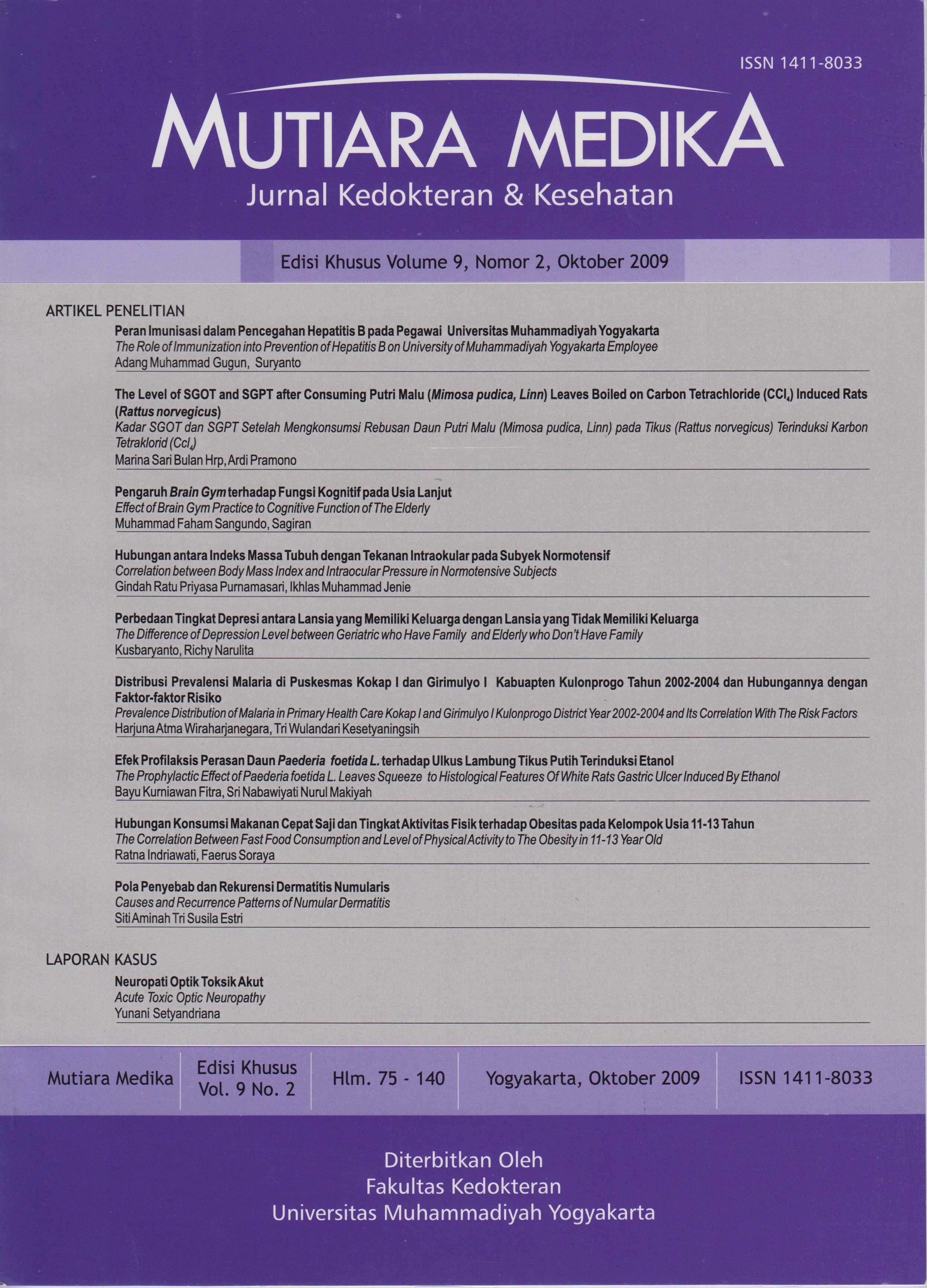Distribusi Prevalensi Malaria di Puskesmas Kokap I dan Girimulyo I Kabuapten Kulonprogo Tahun 2002-2004 dan Hubungannya dengan Faktor-faktor Risiko
DOI:
https://doi.org/10.18196/mmjkk.v9i2%20(s).1613Keywords:
prevalensi malaria, faktor-faktor risiko, malaria prevalence, risk factorsAbstract
Prevalence of malaria in Indonesia is still high, particularly in the areas of Java and Bali. In Java, the health priority areas are endemic areas including mountain areas incise Kulonprogo district. This research aims to reveal the presence of risk factors associated with the incidence of malaria in the area. This is a non-experimental research by reviewing the medical records of patients with malaria in Primary Health Care in Kokap I and Girimulyo I in 2002-2004. Significance of the relationship between risk factors with the prevalence of malaria were analyzed by Chi-Square. The result show that malaria prevalence in Kokap I in 2002-2004 are 37,43%; 2,174%; 0,246% respectively and in Girimulyo I are 3,632%; 0,183%; 0,013% respectively. Chi-squares analyze show that there is significant correlation (p<0,05) between age group, gender and the occupation and the prevalence of malaria. There is unsignificant correlation between education level and the prevalence of malaria (p>0,05) in Kokap and Girimulyo.
Prevalensi malaria di Indonesia sampai saat ini masih tinggi, terutama di daerah Jawa dan Bali. Di daerah Jawa yang menjadi prioritas kesehatan adalah daerah endemik termasuk wilayah pegunungan menoreh Kabupaten Kulonprogo. Penelitian ini bertujuan untuk mengungkap adanya faktor-faktor risiko yang berhubungan dengan kejadian malaria di daerah tersebut. Penelitian ini bersifat non eksperimental dengan menelaah data rekam medik penderita malaria di Kokap I dan Girimulyo I tahun 2002-2004. Signifikansi hubungan antara faktor risiko dengan prevalensi malaria dianalisis dengan Chi-Square. Hasil penelitian menunjukkan bahwa prevalensi malaria di Kokap I berturut-turut dari tahun 2002-2004 adalah 37,43%; 2,174%; 0,246% dan di Girimulyo I, berturut-turut adalah 3,632%; 0,183%; 0,013%. Analisis Chi-Square menunjukkan ada hubungan yang signifikan (p<0,05) antara umur, jenis kelamin, dan jenis pekerjaan dengan prevalensi malaria. Tidak ada hubungan antara tingkat pendidikan dengan prevalensi malaria (P>0,05).
References
WHO, 2000. Notes on Anti-Malarial Drugs (annex 1). Management of Severe Malaria. 2nd edition. WHO Graphics. Malta. pp. 57-60.
Anon. 2005. Laporan Perkembangan Pencapaian Tujuan Pembangunan Millenium. Available at : www.undp.or.id
Silalahi, L., 2004. Apa dan Bagaimana Mengatasi Malaria. Available at: www.tempointeraktif.com/hg/narasi/ 2004/03/28/nrs,20040328- 01,id.html
Depkes, R.I. 1995. Malaria. Dit Jen PPM-PLP. Malaria No.3: Pengobatan. Jakarta.
Muhtar, S., 2003. Epidemiologi Malaria. Available at: www.pikiran- rakyat.com
Arsin A dan R. Aminuddin. 2005. Some factor related ti the prevalance of malaria in East Bitung District, Bitung Town in 2005. Abstrak penelitian epidemiologi. Program S2 Epidemiologi Unhas. Makassar.
Department Health Republic of South Africa. 2008. The prevalence and distribution of malaria in South Africa.
Rogier C, Tall A, Diagne N, Fontenille D, Spiegel A, et al. 1999. Plamodium falciparum clinical malaria: lessons from longitudinal studies in Senegal. Parassitologia:41:255-9 (PubMed).
Hiswani. 2004. Gambaran penyakit dan vektor malaria di Indonesia. FKM.USU. dari http:// library.usu.ac.id/download/fkm/fkm- hiswani.pdf
Downloads
Published
Issue
Section
License
Copyright
Authors retain copyright and grant Mutiara Medika: Jurnal Kedokteran dan Kesehatan (MMJKK) the right of first publication with the work simultaneously licensed under an Attribution 4.0 International (CC BY 4.0) that allows others to remix, adapt and build upon the work with an acknowledgment of the work's authorship and of the initial publication in Mutiara Medika: Jurnal Kedokteran dan Kesehatan (MMJKK).
Authors are permitted to copy and redistribute the journal's published version of the work (e.g., post it to an institutional repository or publish it in a book), with an acknowledgment of its initial publication in Mutiara Medika: Jurnal Kedokteran dan Kesehatan (MMJKK).
License
Articles published in the Mutiara Medika: Jurnal Kedokteran dan Kesehatan (MMJKK) are licensed under an Attribution 4.0 International (CC BY 4.0) license. You are free to:
- Share — copy and redistribute the material in any medium or format.
- Adapt — remix, transform, and build upon the material for any purpose, even commercially.
This license is acceptable for Free Cultural Works. The licensor cannot revoke these freedoms as long as you follow the license terms. Under the following terms:
Attribution — You must give appropriate credit, provide a link to the license, and indicate if changes were made. You may do so in any reasonable manner, but not in any way that suggests the licensor endorses you or your use.
- No additional restrictions — You may not apply legal terms or technological measures that legally restrict others from doing anything the license permits.






